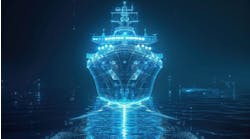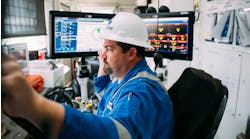Weather app provides blend of forecast, measurement data in single display
By Ariana Hurtado, Editor and Director of Special Reports
HOUSTON — Weather conditions can significantly impact offshore energy operations and the maintenance of equipment. By integrating forecast data with real-time measurements in one application, maritime companies can make informed decisions without switching between multiple applications by utilizing Norway-based Miros Group's latest weather forecasting app.
Miros, a technology company that specializes in measuring the ocean surface, provides real-time wave, current and weather data to help improve efficiencies for offshore operations. Miros says it aims to support operators by developing sophisticated technologies that navigate challenges, optimize operations and prioritize safety in the offshore environment.
In late October, Miros advanced its Miros Cloud Home solution (miros.app) by integrating weather forecast layers into the application. The new version of Miros Cloud Home incorporates popular weather forecasting conditions using the Windy software to provide accurate real-time wave, current and weather measurements. Miros says the technology offers maritime users access to a range of forecast map layers visually animated on a global scale to customize their user experience and receive insights into current and future weather conditions.
The platform provides 17 interactive map layers that allow users to visualize factors such as wind, waves and currents. Using an interactive menu, Miros says users can access short-term or long-term predictions up to 10 days of future conditions to explore how these are likely to evolve.
The Miros Cloud Home can be used for offshore operations, offshore wind, oil and gas, ports, and coastal and shipping sectors.
In this Q&A, Chief Commercial Officer Jonas Røstad recently shared details with Offshore about the company's latest weather forecasting and measurement technology.
Offshore: What is the offshore energy sector's need for this type of technology?
Røstad: It is a well understood fact in the offshore energy sector that being aware of the forces of sea and weather is fundamental to operational excellence. According to research firm Gartner, by the end of 2025, 90% of energy and utility companies will experience significant operational disruptions due to adverse weather events.
To guard against this potential threat, weather forecasts are widely used in the industry and the benefits of real-time, accessible measurements are now better understood by users. Windy is a free-of-charge forecast software that is excellent for planning and examining wider trends, meaning users can see if there’s rough weather on the horizon.
But accuracy at a specific point at a specific time can vary a lot. There may be a storm coming in, but it could be hitting later than the forecasts have indicated—that can make a big difference to operations. That’s why measurement is needed, to accurately determine the weather at any given location.
If you mix forecast and measurement, then you can get the best of both worlds; they should be complementing each other rather than competing as they serve different purposes. At Miros we have been feeding back our data to forecasts since the 1980s, but having these two products combined in one display is relatively uncommon. With this additional layer you have accuracy married with value. If the offshore energy sector is to be prepared, only future-proof technology can serve the purpose.
Offshore: Explain in general how other technologies failed to meet that need.
Røstad: Put simply, the most important thing to know is the relevant sea state. For some applications, having a generic understanding of the sea conditions is sufficient, but feedback from our customers tells us that having forecasts alone isn’t enough to guarantee safe operations.
Part of the problem is that forecast companies are software companies, while the sensor companies are hardware companies. We haven’t seen any hardware companies in our market that are also good at software, other than Miros—we are the only provider of combined radar fusion systems. Our focus will never fully shift from the hardware side because ocean conditions need to be accurately measured and that’s our heritage, but these days we are spending as much time advancing our user applications.
In short, it's not about the sensor; it’s about the data and the value created from it and making that actionable for the user. Miros has different types of sensors with different scopes that we mix for superior excellence and combine with forecasts to allow for planning.
Offshore: Can you share any additional work planned to put into development?
Røstad: One breakthrough that we foresee is putting real-time data into dynamic positioning (DP) systems; that’s been something of a Holy Grail for the maritime sector since the 1980s. In the past, the technology wasn’t good enough, but nowadays it’s a real possibility and we are in discussions with various DP companies on how we best integrate data. Doing so would reduce drift and would mean that vessels can prioritize their fuel use, so there’s a sustainability aspect to this too. There have been tests and trials around this, and it’s certainly something to keep an eye on.
Offshore: What's next for Miros as we start to conclude 2023?
Røstad: We recently announced a contract with Brazilian oil major Petrobras, through our local partner Belga Marine, to update our existing oil spill detection efforts in the region. Our system will be matured and installed with a cloud-based add-on to the monitoring software to bring it up to speed with local regulations.
As always, we will help and work with our customers to take the lead in precisely measuring and analyzing ocean conditions, waves, currents, speed-through-water and detecting oil spills—all of which are pivotal elements for offshore activities on vessels, platforms, wind farms, and coastlines.
As we move forward into 2024, we will continue to disrupt and revolutionize the way the sector approaches wave and vessel movement prediction by combining the qualities of several Miros sea state measurement solutions to create a valuable holistic offering.
Offshore: What's the path forward for the offshore energy industry and the digitalization evolution?
Røstad: All the big software companies are now aiming to digitalize everything on vessels and platforms. But once you have digitized something and got 1,000s of datapoints, then what? They have no understanding of whether that data is good quality or relevant, or whether it is actually useful to fix a problem. If you’re going to collect data, it needs to be meaningful to create proper value.
A cornerstone of that is sharing the information you have with your stakeholders and partners, and hardware without seamless cloud integration doesn’t make sense anymore in today’s modern IT infrastructure.
No doubt, digitalization will and should have a significant role in deciding how sea state measurement and monitoring solutions best support the offshore sector, ensuring businesses stay future-proof and ready to tackle the challenges and requirements of tomorrow.
11.20.2023






